
Acropora is a genus of small polyp stony coral in the phylum Cnidaria. Some of its species are known as table coral, elkhorn coral, and staghorn coral. Over 149 species are described. Acropora species are some of the major reef corals responsible for building the immense calcium carbonate substructure that supports the thin living skin of a reef.

Acropora secale is a species of branching staghorn stony coral. It is found in shallow parts of the Indo-Pacific Ocean and the type locality is Sri Lanka. The oldest fossils found date back to the Pleistocene.

Acropora pulchra is a species of colonial staghorn coral in the family Acroporidae. It is found on the back fringes of reefs in shallow water in the western Indo-Pacific Ocean. The oldest fossils of this species date back to the Pleistocene.

Acropora aspera is a species of staghorn coral in the family Acroporidae. It is found on reef flats and in lagoons in very shallow water in the western Indo-Pacific Ocean.
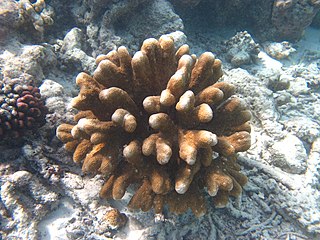
Isopora palifera is a species of stony coral in the family Acroporidae. It is a reef building coral living in shallow water and adopts different forms depending on the water conditions where it is situated. It is found in the Western Indo-Pacific Ocean as far east as Australia.
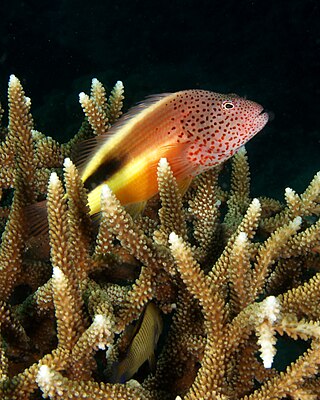
Acropora grandis is a species of colonial stony coral. It is a large species with multiple branches forming a bush-like structure and is found on reefs and in lagoons. It is native to the tropical western Indo-Pacific and has a range extending from East Africa to the east coast of Australia.

Acropora loripes is a species of branching colonial stony coral. It is common on reefs, upper reef slopes and reef flats in the tropical Indo-Pacific. Its type locality is the Great Barrier Reef.
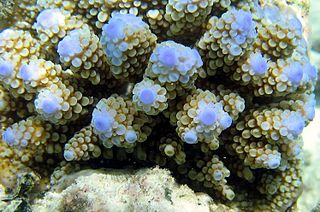
Acropora nasuta is a species of branching stony coral in the family Acroporidae. It is native to the western and central Indo-Pacific where it is found in shallow reef habitats. Like other corals of the genus Acropora, it is susceptible to coral bleaching and coral diseases and the IUCN has listed it as being "Near Threatened".

Acropora muricata, commonly called staghorn coral, is a species of acroporid coral found in the Gulf of Aden, the Red Sea, Indian Ocean, Persian Gulf, Australia, central Indo-Pacific, Japan, Southeast Asia, the East China Sea and the oceanic central and western Pacific Ocean. It is found in tropical shallow reefs, slopes of reefs, and in lagoons, from depths of 5 to 30 m. It was described by Dana in 1846.

Acropora microphthalma is a species of acroporid coral found in the Red Sea, the Gulf of Aden, the southwest and northern Indian Ocean, the central Indo-Pacific, Australia, Southeast Asia, Japan, the East China Sea and the oceanic west and central Pacific Ocean. It is also found in the Line Islands. It occurs in shallow tropical reefs on upper reef slopes, in turbid water and in sandy lagoons. It can be found from depths of 5–25 m.
Acropora subglabra is a species of acroporid coral found in the northern Indian Ocean, the central Indo-Pacific, Australia, Southeast Asia, Japan, the East China Sea and the oceanic west Pacific Ocean. It occurs in tropical shallow reefs, and its range is often restricted to sheltered back reefs containing soft substrates and clear water. It can be found from depths of 5 to 15 metres and was described by Brook in 1891.

The branch coral is a species of acroporid coral found in the southwest and northern Indian Ocean, the central Indo-Pacific, Australia, Southeast Asia, Japan and the East China Sea, Cook Islands and the oceanic west Pacific Ocean. It can be found in shallow reefs on the reef tops, walls and slopes to depths of 30 m.
Acropora derawanensis is a species of acroporid coral that was first described by Carden Wallace in 1997. Found in tropical, shallow reefs sheltered from the waves in a marine environment, it is found at depths of 10 to 25 m on reef slopes. The species is rated as vulnerable on the IUCN Red List, with a decreasing population. It is not common but found over a large area, and is listed on CITES Appendix II. It is easily damaged.

Acropora donei is a species of acroporid coral that was first described by J. Veron and Carden Wallace in 1984. Found in fringing reefs and the upper slopes of shallow reefs, it occurs at depths of 5 to 20 m. The species is rated as vulnerable on the IUCN Red List, with a decreasing population, and is affected by disease. It is not common but found over a large area, and is listed under CITES Appendix II.
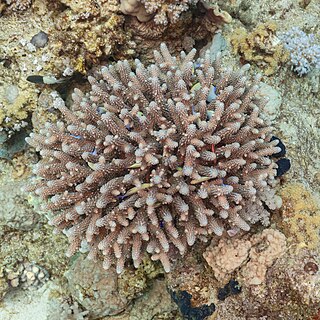
Acropora hemprichii is a species of acroporid coral that was first described by Christian Gottfried Ehrenberg in 1834. It lives in reefs at depths of 3 to 15 m for between 13 and 24 years. The species is listed as vulnerable on the IUCN Red List, and has a decreasing population. It is common with a wide range, and is listed on Appendix II of CITES.
Acropora kirstyae is a species of acroporid coral that was first described by Jen Veron and C. C. Wallace in 1984. Found in marine, tropical, shallow reefs in sheltered areas usually at depths of 10 to 25 m, and also occurs in sheltered lagoons. It is listed as a vulnerable species on the IUCN Red List, and it is thought to have a decreasing population. It is not common and found over a large area, and is listed on CITES Appendix II.

Acropora microclados is a species of acroporid coral that was first described by Christian Gottfried Ehrenberg in 1834. Found in marine, tropical shallow reefs on the upper slopes, it is found at depths of 5 to 20 m. It is listed as a vulnerable species on the IUCN Red List, and its population is decreasing. It is uncommon but found over a large area, including in five regions of Indonesia, and is classified under CITES Appendix II.
Acropora multiacuta is a species of acroporid coral that was first described by F. Nemenzo in 1967. Found in marine, tropical shallow reefs in lagoons, on rocks or on the tops of reefs, it occurs at depths between 3 and 15 m. It is classed as a vulnerable species on the IUCN Red List, and it has a decreasing population. It is uncommon but found over a large area, including in two regions of Indonesia and the Great Barrier Reef, and is classified under CITES Appendix II.
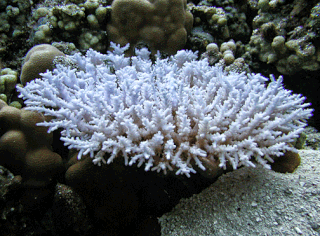
Acropora paniculata is a species of acroporid coral that was first described by Addison Emery Verrill in 1902. Found in marine, tropical, shallow reefs on the upper slopes, it occurs at depths of between 10 and 35 m. It is classed as a vulnerable species on the IUCN Red List, and it has a decreasing population. It is uncommon but found over a large area, including in five regions of Indonesia, and is classified under CITES Appendix II.
Gyrosmilia is a monotypic genus of large polyp stony coral. It is represented by a single species, Gyrosmilia interrupta. It was first described by Christian Gottfried Ehrenberg in 1834 as Manicina interrupta.
















